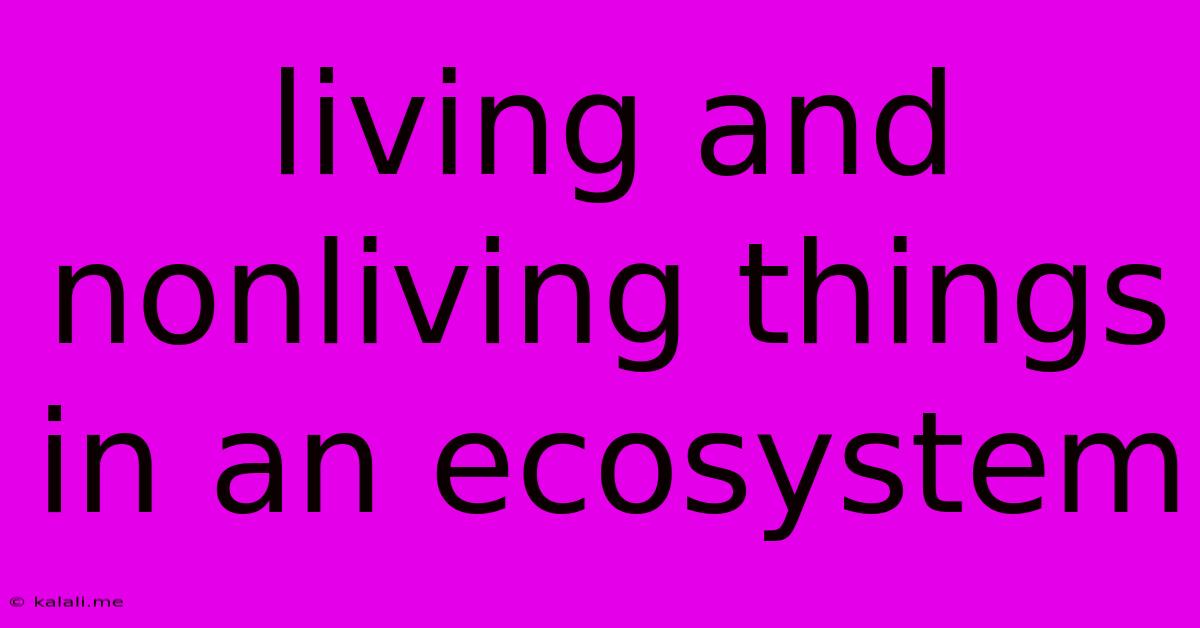Living And Nonliving Things In An Ecosystem
Kalali
May 09, 2025 · 3 min read

Table of Contents
Living and Nonliving Things: The Intertwined Threads of an Ecosystem
Meta Description: Discover the fascinating interplay between living (biotic) and nonliving (abiotic) components in an ecosystem. Learn how they interact, their importance, and the consequences of imbalance. This comprehensive guide explores the vital roles of producers, consumers, decomposers, and abiotic factors like sunlight and water.
An ecosystem is a vibrant, dynamic community where living organisms interact with each other and their nonliving environment. Understanding this intricate relationship between biotic (living) and abiotic (nonliving) factors is key to comprehending the health and stability of any ecosystem, whether it's a lush rainforest, a bustling coral reef, or a seemingly barren desert. This article delves into the crucial roles played by both living and nonliving things, exploring their interdependence and the consequences of disruption to this delicate balance.
What are Biotic Factors?
Biotic factors encompass all the living components within an ecosystem. These are categorized broadly into three groups:
-
Producers (Autotrophs): These are organisms that can produce their own food, typically through photosynthesis. Plants are the primary producers in most terrestrial ecosystems, converting sunlight, water, and carbon dioxide into energy-rich sugars. Phytoplankton plays a similar role in aquatic environments.
-
Consumers (Heterotrophs): Consumers rely on other organisms for food. This group includes:
- Herbivores: Animals that eat plants (e.g., rabbits, deer, grasshoppers).
- Carnivores: Animals that eat other animals (e.g., lions, wolves, sharks).
- Omnivores: Animals that eat both plants and animals (e.g., bears, humans, raccoons).
-
Decomposers (Detritivores): These organisms break down dead organic matter, recycling essential nutrients back into the ecosystem. Bacteria, fungi, and some insects are crucial decomposers, ensuring the continuous flow of nutrients.
The Crucial Role of Abiotic Factors
Abiotic factors are the nonliving components of an ecosystem. They provide the physical and chemical conditions that shape the environment and influence the distribution and abundance of living organisms. Key abiotic factors include:
-
Sunlight: The primary source of energy for most ecosystems, driving photosynthesis and influencing temperature.
-
Water: Essential for all life processes, influencing the type and distribution of organisms. Water availability dictates the types of plants and animals that can survive in a particular region.
-
Temperature: Affects metabolic rates and the survival of many organisms. Temperature extremes can limit the biodiversity of an area.
-
Soil: Provides nutrients and anchorage for plants, influencing the types of vegetation that can grow. Soil composition, pH, and nutrient levels are all critical.
-
Air: Provides oxygen for respiration and carbon dioxide for photosynthesis. Air quality significantly impacts the health of the ecosystem and its inhabitants.
-
Minerals: Essential nutrients for plant growth and are crucial for the health of the entire ecosystem. These include nitrogen, phosphorus, and potassium, which are often limiting factors for plant growth.
The Interdependence of Biotic and Abiotic Factors
The biotic and abiotic components of an ecosystem are intricately interwoven. For instance, the availability of water (abiotic) directly impacts plant growth (biotic), which in turn affects the populations of herbivores and subsequently carnivores. Similarly, soil nutrients (abiotic) influence plant productivity (biotic), impacting the entire food web. Changes in any one component can trigger a cascade of effects throughout the entire ecosystem.
Consequences of Imbalance
Disruptions to the delicate balance between biotic and abiotic factors can have severe consequences. Deforestation, pollution, climate change, and habitat destruction all threaten ecosystem stability. These disruptions can lead to:
-
Loss of Biodiversity: The extinction of species due to habitat loss or altered environmental conditions.
-
Reduced Ecosystem Services: Decreased provision of essential services like clean water, pollination, and carbon sequestration.
-
Increased vulnerability to Invasive Species: Native species may be outcompeted by invasive species that thrive in disturbed ecosystems.
Understanding the complex interplay between living and nonliving things is crucial for conservation efforts and sustainable management of our planet's resources. By appreciating the interconnectedness of all components within an ecosystem, we can work towards preserving the biodiversity and resilience of these vital systems.
Latest Posts
Latest Posts
-
What Percent Of 50 Is 30
May 09, 2025
-
Cuanto Es 10 Km En Millas
May 09, 2025
-
38 Degrees Fahrenheit Converted To Celsius
May 09, 2025
-
One Third Of A Cup In Ounces
May 09, 2025
-
Which Shows Two Triangles That Are Congruent By Asa
May 09, 2025
Related Post
Thank you for visiting our website which covers about Living And Nonliving Things In An Ecosystem . We hope the information provided has been useful to you. Feel free to contact us if you have any questions or need further assistance. See you next time and don't miss to bookmark.